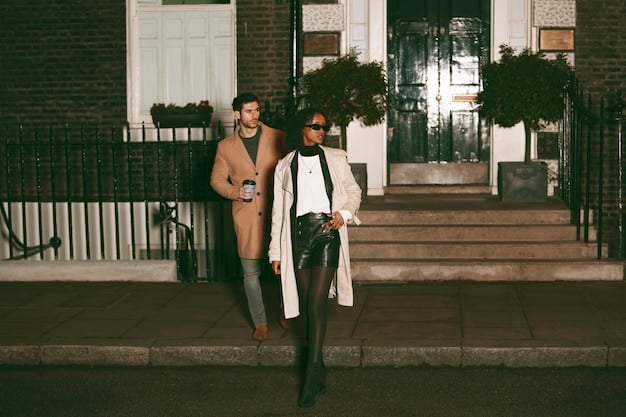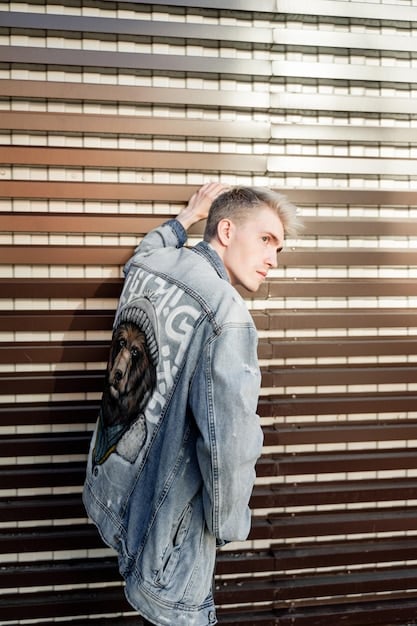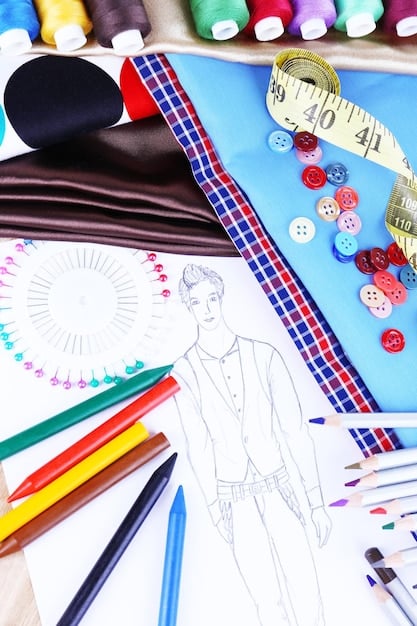Gender-Neutral Fashion: Breaking Barriers & Embracing Inclusivity

Anúncios
The rise of gender-neutral fashion signifies a profound societal shift, moving beyond traditional binary clothing norms to foster inclusivity and individual expression, reflecting evolving attitudes towards identity.
The fashion landscape is undergoing a revolutionary transformation, challenging long-held conventions and embracing a more expansive vision of style. This profound shift is encapsulated in the rise of gender-neutral fashion: breaking down barriers and embracing inclusivity, a movement that transcends mere aesthetic preference to reflect deeper societal changes. It’s an exciting time to witness how clothing is evolving to reflect diverse identities and expressions, moving far beyond rigid definitions.
Anúncios
Understanding gender-neutral fashion
Gender-neutral fashion, often interchangeably referred to as unisex or agender fashion, represents a significant departure from the traditional compartmentalization of clothing into distinct male and female categories. At its heart, this movement seeks to create garments that can be worn by anyone, regardless of their gender identity or expression. It champions the idea that clothing should be a tool for self-expression, unburdened by societal expectations tied to sex.
Historical context of clothing and gender
To truly appreciate the contemporary rise of gender-neutral fashion, it’s essential to briefly consider the historical context of how clothing became so intrinsically linked to gender. For centuries, garments were often functional or indicative of social status, with gender distinctions gradually solidifying over time. The concept of “womenswear” and “menswear” as we know it today is a relatively modern construct, heavily influenced by industrialization and the rise of mass production. Historically, styles like tunics, kilts, and robes were worn by various genders in different cultures, highlighting a more fluid approach to dress.
However, the 19th and 20th centuries saw a reinforcement of gendered apparel, with women’s fashion emphasizing form and decoration, and men’s fashion prioritizing practicality and sobriety. This binary system became deeply ingrained, influencing everything from garment cut to fabric choices and color palettes. Breaking free from these established norms requires a deliberate and conscious effort to re-evaluate what clothing signifies.
Anúncios
Key characteristics and design principles
What defines gender-neutral fashion from a design perspective? It’s not simply about making clothes shapeless or bland. Instead, it involves a thoughtful approach to cut, silhouette, and detailing that can appeal to a broad spectrum of body types and personal tastes. Key characteristics often include:
- Relaxed silhouettes: Moving away from highly tailored or form-fitting garments that emphasize traditionally gendered body shapes. Think oversized blazers, wide-leg trousers, and relaxed-fit shirts.
- Versatile cuts: Designs that allow for flexibility in styling and can be interpreted differently by individuals. A single garment might be worn as a dress by one person and a long tunic over pants by another.
- Neutral color palettes: While not exclusive, many gender-neutral collections favor earthy tones, greys, blacks, whites, and muted shades, which are often perceived as universally appealing.
- Minimalist aesthetics: Often, there’s a focus on clean lines, functional elements, and an absence of overtly masculine or feminine embellishments.
- Durable fabrics: A push towards high-quality, long-lasting materials that are comfortable and can withstand diverse wearers and uses.
These design principles are not restrictive but rather liberating, allowing designers to focus on innovation and comfort over prescribed gender roles. The goal is to create clothing that feels authentic and adaptable to the wearer, rather than dictating how they should present themselves.
The ethos of gender-neutral fashion extends beyond just the clothes; it’s about shifting mindsets, both within the design community and among consumers. It emphasizes comfort, versatility, and the inherent right of an individual to dress in a way that truly reflects who they are, without external judgment based on gender. This holistic approach signals a maturation of the fashion industry towards greater empathy and understanding.
Drivers behind the movement
The rising tide of gender-neutral fashion is not an isolated phenomenon but rather a reflection of broader societal, cultural, and economic shifts. Several powerful drivers have converged to pave the way for this inclusive approach to style, moving it from a niche concept to a significant trend in the mainstream fashion industry.
Evolving societal norms and identity politics
Perhaps the most significant driver is the profound evolution in societal norms surrounding gender identity and expression. Younger generations, in particular, are increasingly rejecting rigid binary definitions of gender, embracing a more fluid and expansive understanding of identity. This cultural shift translates directly into a desire for clothing that does not constrain or misrepresent one’s authentic self. As conversations around gender diversity become more prevalent and accepted, so too does the demand for fashion that mirrors this inclusivity.
Activists, artists, and thought leaders have played a crucial role in normalizing these discussions, creating a space where individuals feel empowered to express their true identities. This increased visibility and acceptance of diverse gender expressions naturally fuels the demand for clothing that caters to a wider spectrum of identities, moving away from the narrow confines of “menswear” and “womenswear.” The digital age has also amplified these voices, allowing for rapid dissemination of ideas and challenging traditional power structures.
Influence of Gen Z and millennials
Generations Z and Millennials are at the forefront of this movement, bringing with them a new set of values that prioritize authenticity, individuality, and social consciousness. Unlike previous generations, they are less tethered to traditional gender roles and more open to blurring lines in all aspects of life, including fashion. This demographic is significant not just for its size, but for its purchasing power and its influence on cultural trends.
These generations are digital natives, exposed to a global array of styles and identities through social media platforms. This constant visual input normalizes diverse expressions and encourages experimentation. They seek clothing that reflects their values of inclusivity and sustainability, often preferring brands that demonstrate social responsibility and align with their progressive outlook. For Gen Z and Millennials, fashion is less about conforming and more about expressing a unique identity and values.
Sustainability and functional appeal
Beyond identity, practical considerations like sustainability and functional appeal are also playing a vital role. In an era of increased environmental awareness, consumers are demanding more sustainable practices from the fashion industry. Gender-neutral designs often lend themselves well to sustainable production because they can be produced in higher volumes with fewer variations, potentially reducing waste. The versatility of gender-neutral pieces also encourages consumers to buy fewer, more durable items that can be styled in multiple ways, promoting a more conscious consumption habit.

Furthermore, the functional appeal of gender-neutral clothing is undeniable. Many designs prioritize comfort, durability, and practicality, qualities that are universally appealing. The emphasis on relaxed fits and adaptable silhouettes means garments are often more comfortable for everyday wear, appealing to a broader section of the population seeking practical yet stylish options. This utilitarian aspect contributes to the widespread acceptance of these designs outside of niche fashion circles.
Each of these drivers, though distinct, synergizes to create a compelling case for the continued growth and mainstream acceptance of gender-neutral fashion. They represent not just a trend, but a fundamental shift in how society views gender, clothing, and individual expression, promising a more inclusive and mindful future for the fashion industry.
Impact on the fashion industry
The embrace of gender-neutral fashion has sent ripples through the core of the fashion industry, prompting significant changes in design, marketing, retail, and even corporate philosophy. This paradigm shift challenges established norms and opens up new avenues for creativity and commerce.
Design and collections: breaking binary molds
For designers, gender-neutrality is a liberating force, allowing them to stretch their creative muscles beyond the confines of traditional menswear and womenswear collections. It encourages a focus on innovative cuts, versatile fabrics, and adaptable silhouettes that emphasize form, texture, and movement rather than prescribed gender aesthetics. Instead of designing for a specific gender, designers are now thinking about functionality, comfort, and how a garment can be interpreted by a diverse range of bodies and personal styles.
We see more brands launching dedicated “unisex” lines or even entire collections designed with a gender-agnostic approach. This often involves oversized cuts, drop shoulders, wider leg pants, and convertible pieces that can be styled in multiple ways. The emphasis shifts from “feminine” or “masculine” details to universal appeal, quality construction, and timeless designs. This evolution pushes designers to be more imaginative and less constrained by historical fashion norms.
Marketing and advertising strategies
The marketing and advertising landscape is also undergoing a radical transformation. Traditional campaigns that feature highly gendered models in stereotypical poses are being replaced by more inclusive imagery. Brands are now showcasing a diverse cast of models with varying body types, ethnicities, and gender expressions, all wearing the same garments. This authentic representation resonates deeply with modern consumers who value inclusivity and honesty in branding.
Key changes in marketing strategies include:
- Diverse casting: Featuring models across the gender spectrum, often non-binary individuals, to better reflect the target audience.
- Campaign narratives: Shifting from overtly sexualized or gender-normative narratives to stories that celebrate individuality, comfort, and self-expression.
- Digital engagement: Leveraging social media to engage directly with consumers, fostering communities around shared values of inclusivity.
- Product descriptions: Using gender-neutral language when describing garments, focusing on features and benefits applicable to all.
This approach not only appeals to a wider audience but also builds stronger brand loyalty by demonstrating a commitment to progressive values. Effective gender-neutral marketing is subtle yet powerful, reflecting a deeper understanding of today’s diverse consumer base.
Retail experience and sales implications
The move towards gender-neutrality has significant implications for the retail environment. Traditional store layouts, usually segregated by “men’s” and “women’s” sections, are being rethought. Some forward-thinking retailers are experimenting with co-ed sections or entirely gender-neutral departments, allowing customers to browse clothing based on style, color, or function rather than predefined gender categories. This creates a more welcoming and less restrictive shopping experience for everyone.
From a sales perspective, gender-neutral fashion opens up new market opportunities. Brands are tapping into previously underserved demographics and appealing to consumers who traditionally felt excluded by binary fashion offerings. While precise sales data is still emerging, anecdotal evidence and the increasing number of brands adopting this approach suggest a growing demand. Furthermore, the versatility of gender-neutral pieces can potentially lead to higher sales volumes per item, as they appeal to a broader customer base, thus maximizing inventory efficiency.
In essence, the impact of gender-neutral fashion on the industry is profound and multifaceted. It’s driving innovation in design, fostering more inclusive marketing practices, and reshaping the retail experience, positioning the fashion world to be more reflective of and responsive to the complexity and diversity of contemporary identity.
Challenges and considerations
While the momentum behind gender-neutral fashion is undeniable, its widespread adoption is not without challenges. Navigating these obstacles requires a thoughtful approach from designers, retailers, and consumers alike, balancing the ideals of inclusivity with the practicalities of the industry.
Overcoming traditional consumer mindsets
For many consumers, the long-standing tradition of gendered clothing is deeply ingrained. Generations have been conditioned to shop in “men’s” or “women’s” sections, and to associate certain styles, colors, and cuts with specific genders. Shifting this deeply held mindset requires education and exposure. Some consumers may initially feel confused or even resistant to the idea of gender-neutral clothing, unsure of how to incorporate it into their existing wardrobes or how it fits their personal style. Retailers face the challenge of re-educating their customer base and creating a shopping environment that encourages exploration and experimentation rather than adherence to old norms.
Sizing and fit complexities
One of the most practical challenges in designing and selling gender-neutral clothing lies in sizing and fit. Human bodies are diverse, and traditional sizing charts are often based on gender-specific proportions (e.g., a “women’s size M” versus a “men’s size M”). Creating garments that fit well and flatter a wide range of body types, regardless of gender, without relying on overly baggy or shapeless designs, is a significant hurdle. Some brands are experimenting with flexible sizing systems, open garment designs, or detailed measurement guides to assist consumers. However, achieving a universal fit that satisfies everyone remains a complex engineering and design problem.

Marketing authenticity and avoiding tokenism
As gender-neutral fashion gains traction, brands must be mindful of marketing authenticity. There’s a fine line between genuinely embracing inclusivity and merely co-opting the trend for profit (often referred to as “rainbow washing” or tokenism). Consumers, especially younger generations, are discerning and quick to spot inauthentic efforts. Brands need to ensure their commitment to gender-neutrality extends beyond just the products to their workplace culture, their broader social responsibility initiatives, and the diversity of their teams.
Authentic marketing involves:
- Genuine representation: Featuring models and spokespeople from diverse gender identities, not just for show.
- Substantive brand values: Demonstrating a real commitment to inclusivity, rather than just superficial nods.
- Transparent communication: Being honest about efforts and challenges on the journey towards greater inclusivity.
- Avoiding stereotypes: Ensuring that the portrayal of gender-neutrality doesn’t inadvertently create new forms of stereotypes.
Navigating these challenges successfully will be key to the sustained growth and acceptance of gender-neutral fashion. It requires an industry-wide commitment to innovation, education, and genuine inclusivity, moving beyond mere trends to foster lasting change.
The future of fashion: a fluid landscape
Looking ahead, the trajectory of gender-neutral fashion suggests a future where fluidity and individuality are paramount. This isn’t merely a fleeting trend but a foundational shift that will continue to reshape how we perceive, create, and consume clothing.
Integration into mainstream fashion
The initial niche appeal of gender-neutral fashion is rapidly giving way to its integration into the mainstream. High-street brands, once cautious, are increasingly introducing unisex lines or designing collections that inherently blur gender distinctions. Major fashion weeks are seeing more co-ed shows and designers pushing boundaries, leading to designs that are less about “him” or “her” and more about “us.” This mainstreaming will gradually normalize the concept, making gender-neutral clothing an expected offering rather than a radical alternative.
Expect to see more everyday items, from basic tees to outerwear, designed with a universal appeal. Retail spaces will continue to evolve, with less rigid segmentation and more curated displays that focus on style and category rather than gender. This widespread adoption will make gender-neutral fashion accessible to a broader demographic, moving it beyond high fashion labels to become part of the everyday wardrobe.
Personalization and individual expression
The essence of gender-neutral fashion is deeply tied to personalization and individual expression. As traditional sartorial boundaries dissolve, individuals are empowered to curate their style based purely on personal preference, comfort, and aesthetic appeal, rather than societal dictates. The future will likely see an even greater emphasis on customized pieces, modular clothing, and styling techniques that allow wearers to adapt garments to their unique identities.
This includes an increased focus on:
- Styling versatility: Garments designed to be worn in multiple ways, encouraging creative interpretation.
- Upcycling and customization: Consumers modifying gender-neutral pieces to better suit their individual taste.
- Body positivity: A continued emphasis on designing clothes that celebrate diverse body shapes and proportions without gendered expectations.
- Digital fashion and avatars: Virtual clothing that is inherently gender-agnostic, further blurring lines in the digital realm.
This trend towards hyper-personalization underscores that gender-neutrality is not about uniformity, but about providing a wider canvas for self-discovery and unique self-presentation.
Beyond clothing: challenging norms in other industries
The impact of gender-neutrality is unlikely to remain confined to the fashion industry. The ripples of this movement are already being felt in other sectors, as brands and businesses re-evaluate their products, services, and marketing through an inclusive lens. We see this in beauty (gender-neutral skincare and makeup lines), toys (breaking down gendered toy aisles), and even in language (use of inclusive pronouns and terminology).
The fashion industry, often an early adopter of cultural shifts, is serving as a powerful catalyst. Its embrace of gender fluidity sets a precedent for other consumer-facing industries to challenge their own binary constructs and embrace a more inclusive approach. The momentum gathered by gender-neutral fashion is therefore more than just a style phenomenon; it’s a testament to a broader cultural awakening that values diversity, authenticity, and self-determination above all else. The future promises a more expansive and less restrictive landscape, where fashion truly is for everyone.
| Key Point | Brief Description |
|---|---|
| 👕 Inclusive Design | Fashion designed for all, independent of gender identity, focusing on versatile cuts and universal appeal. |
| 🌍 Societal Shift | Driven by evolving norms around gender identity, particularly among Gen Z and Millennials. |
| 💹 Industry Impact | Reshaping design, marketing, and retail strategies, fostering creativity and new market opportunities. |
| 🧵 Future Outlook | Increasing integration into the mainstream, promoting personalization, and influencing other industries. |
Frequently Asked Questions About Gender-Neutral Fashion
Gender-neutral fashion refers to clothing designed to be worn by anyone, regardless of their gender identity or expression. It moves away from traditional binary labels like “menswear” or “womenswear,” focusing instead on universal appeal, versatile cuts, and personal expression, allowing individuals to choose garments based on preference rather than societal norms.
Its rise is largely driven by evolving societal norms concerning gender identity and expression, particularly among younger generations like Gen Z and Millennials. These demographics prioritize inclusivity, authenticity, and sustainability, seeing fashion as a means of self-expression beyond traditional boundaries. Influences from cultural conversations and the desire for practical, versatile clothing also contribute.
It challenges designers to innovate beyond established gendered categories, focusing on adaptable silhouettes and universal appeal. Brands are rethinking marketing strategies to be more inclusive, featuring diverse models and using gender-agnostic language. Retail environments are also adapting, with co-ed sections becoming more common, reflecting a broadened market appeal and new sales opportunities.
Key challenges include overcoming traditional consumer mindsets ingrained with gendered clothing norms and addressing complexities related to sizing and fit for diverse body types. Brands also face the hurdle of maintaining authenticity in their marketing to avoid tokenism, ensuring their commitment to inclusivity is genuine and extends beyond mere trends to real values.
Experts largely view gender-neutral fashion as more than just a passing trend; it represents a fundamental shift towards a more fluid and inclusive future for the industry. Its increasing integration into mainstream fashion, coupled with a growing emphasis on personalization and comfort, suggests it will continue to evolve and become a standard offering, influencing other industries as well.
Conclusion
The trajectory of gender-neutral fashion: breaking down barriers and embracing inclusivity marks far more than a stylistic preference; it signifies a profound societal evolution. This movement reflects a growing desire for authenticity, self-expression, and a comprehensive understanding of identity that transcends traditional binary definitions. As it continues to integrate into mainstream collections and redefine retail experiences, gender-neutral fashion stands as a testament to an industry increasingly aligned with progressive values. It’s a transformative force, fostering a future where clothing truly serves as a universal canvas for individual identity, free from the constraints of outdated conventions.





